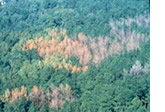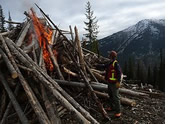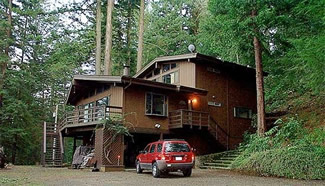Nature Loves Balance— Nature, as dynamic as it is, is always heading towards balance. Humans have upset that balance through pollution, habitat fragmentation and the suppression of forest fires. For the past 100 years, preventing the normal fire cycle has allowed some forests to become overcrowded and build up unnatural amounts of debris. Climate chnage exacerbates that imbalance with its dramatic shifts in temperature and moisture. With less water available per tree and increased competition for nutrients, forests have a hard time thriving.

Trees under stress are less resistant to drought and attack by insects and disease. And warm winters allow insects to avoid winter die-off and accelerate reproduction cycles. Epidemic infestations are killing swaths of forests. Large patches of dead trees can be seen in almost all habitat types. Colorado lost another 400,000 acres in 2008 to bark beetle.
Forest fires burn an average of 1.5 billion tons of fuel per year in the U.S. alone, emitting almost 5 metric tons of greenhouse gases per acre! To reduce the intensity and spread of these fires, the U.S. Forest Service conducts fuel reduction projects on over a million acres of public lands per year, removing over 100 million tons of biomass.
But remove it to where?
 Cutting trees and removing brush in timber sales, thinning projects and forest restoration all create slash: tops of trees, small diameter wood, sticks and debris. This left over material is piled and burned because there's no market for it; this actually adds significant costs to forest projects. Often loggers haul large logs unsuitable for saw timber to mills or container plants to use for pulp, chips, pallets or biomass for co-gen burners. But the cost to haul these logs is often equal to or greater than their current market price. Hauling long distances increases the carbon footprint of the practice even more. The question is, can we intercept some of this dead material and do something intelligent with it before it goes up in smoke?
Cutting trees and removing brush in timber sales, thinning projects and forest restoration all create slash: tops of trees, small diameter wood, sticks and debris. This left over material is piled and burned because there's no market for it; this actually adds significant costs to forest projects. Often loggers haul large logs unsuitable for saw timber to mills or container plants to use for pulp, chips, pallets or biomass for co-gen burners. But the cost to haul these logs is often equal to or greater than their current market price. Hauling long distances increases the carbon footprint of the practice even more. The question is, can we intercept some of this dead material and do something intelligent with it before it goes up in smoke?
Part of the Answer is Biochar— Diverting some of these dead trees and woody debris to the production of biochar can be a multi-solution approach to reducing forest fire risks, climate change impacts and forest health. Pyrolysis units, appropriately sized for the volume of sustainably available biomass, can be a valuable asset to a community or industry, supplying clean alternative energy, heating and cooling needs and power. Where biomass supplies are periodic or small, mobile pyrolysis units, hauled on a trailer to work sites, can be employed. Some mobile units designed to operate near the work site can feed power back into the electric grid. In remote locations, mobile ovens simply convert the biomass to biochar and bio-oil. Ideally, this biochar can be applied on-site to forest soils to enhance productivity. When markets for biochar are robust, some biochar can be sold to off-set the cost of production. Emerging carbon markets may provide further economic balance to biochar production.
 Can We Sustain Healthy Forests?— Absolutely, particularly when we first ensure the sustainability of necessary down and woody debris by NOT taking more than is healthy for that particular habitat type or area. Extensive data exist quantifying the healthy natural biomass load by habitat type. New models allow for an accurate assessment of what we can take out sustainably. Removing dense strands of dead wood and thick undergrowthin most habitat types helps maintain and improve productivity, wildlife habitat and visual quality.
Can We Sustain Healthy Forests?— Absolutely, particularly when we first ensure the sustainability of necessary down and woody debris by NOT taking more than is healthy for that particular habitat type or area. Extensive data exist quantifying the healthy natural biomass load by habitat type. New models allow for an accurate assessment of what we can take out sustainably. Removing dense strands of dead wood and thick undergrowthin most habitat types helps maintain and improve productivity, wildlife habitat and visual quality.
New roads are unnecessary and ill-advised as there is plenty of biomass in already-roaded areas. Of great concern are the huge amounts of biomass in the wildland-urban interface, that is, where people have built homes in forests at the edges of communities. The wildland-urban interface has a disproportionately high incidence of wildfire ignitions, fire risk to people and property and expensive and dangerous fire suppression. And that's where we can do the most good: removing biomass in forests that are already compromised by development but maintaining their productivity and beauty.
Click here for a printer friendly version.
To view our new brochure on biochar, forests and defensible space click here